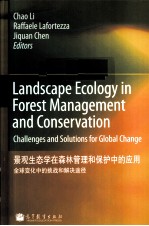
- 作 者:Chao Li,Raffaele Lafortezza,Jiquan Chen
- 出 版 社:北京:高等教育出版社
- 出版年份:2010
- ISBN:9787040291360
- 标注页数:403 页
- PDF页数:423 页
请阅读订购服务说明与试读!
订购服务说明
1、本站所有的书默认都是PDF格式,该格式图书只能阅读和打印,不能再次编辑。
2、除分上下册或者多册的情况下,一般PDF页数一定要大于标注页数才建议下单购买。【本资源423 ≥403页】
图书下载及付费说明
1、所有的电子图书为PDF格式,支持电脑、手机、平板等各类电子设备阅读;可以任意拷贝文件到不同的阅读设备里进行阅读。
2、电子图书在提交订单后一般半小时内处理完成,最晚48小时内处理完成。(非工作日购买会延迟)
3、所有的电子图书都是原书直接扫描方式制作而成。
Part Ⅰ Landscape Ecology and Forest Management 3
Chapter 1 Managing Forest Landscapes under Global Change Scenarios 3
1.1 Introduction 4
1.2 Forest management 6
1.3 New challenges in a changing globe 17
1.4 Landscape ecology contributions 19
1.5 Conclusion remarks 20
References 20
Chapter 2 Landscape Ecology Contributions to Forestry and Forest Management in China:Progresses and Research Needs 22
2.1 Introduction 23
2.2 China's forestry and forest management 25
2.3 Challenges and emerging global issues in forestry 32
2.4 Contributions of landscape ecology to forest management and conservation 34
2.5 Research needs for forest landscape management 37
2.6 Concluding remarks 40
Acknowledgements 41
References 41
Chapter 3 Issues Facing Forest Management in Canada,and Predictive Ecosystem Management Tools for Assessing Possible Futures 46
3.1 A brief history of forestry in Canada 47
3.2 Canada's lands and forests 49
3.3 Issues facing forestry in Canada today 51
3.4 How can Canadian forestry respond to these and other issues?One way is ecosystem management modeling 60
3.5 Conclusions 67
References 68
Part Ⅱ Modeling Disturbance and Succession in Forest LandscapesChapter 4 Challenges and Needs in Fire Management:A Landscape Simulation Modeling Perspective 75
4.1 Introduction 76
4.2 Simulation modeling in fire management 77
4.3 Technical challenges in fire management modeling 79
4.4 A fire management simulation example 82
4.5 Research and management needs and solutions 89
4.6 Summary 92
References 93
Chapter 5 Using Landscape Disturbance and Succession Models to Support Forest Management 99
5.1 Introduction 100
5.2 Overview of landscape disturbance and succession models 101
5.3 Case studies 103
5.4 General conclusions 113
5.5 Future of LDSMs in decision-making 115
Acknowledgements 116
References 116
Chapter 6 Research Methods for Assessing the Impacts of Forest Disturbance on Hydrology at Large-scale Watersheds 119
6.1 Introduction 120
6.2 Definition of large-scale watersheds 122
6.3 Quantification of forest disturbance 123
6.4 Research methods on assessing impacts of forest disturbance on hydrology at large-scale watersheds 126
6.5 Future directions 138
6.6 Conclusions 140
Acknowledgements 141
References 141
Chapter 7 Software Applications to Three-Dimensional Visualization of Forest Landscapes—A Case Study Demonstrating the Use of Visual Nature Studio(VNS)in Visualizing Fire Spread in Forest Landscapes 148
7.1 Introduction 149
7.2 Forest landscape visualization 150
7.3 Results and discussion 167
7.4 Conclusion 172
7.5 Future wildfire visualization research 173
Acknowledgements 174
References 174
Chapter 8 Predicting Tree Growth Dynamics of Boreal Forest in Response to Climate Change 176
8.1 Introduction 176
8.2 Materials and methods 178
8.3 Results 191
8.4 Discussion 198
8.5 Conclusions 202
Acknowledgements 202
References 203
Part Ⅲ Emerging Approaches in Forest Landscape Conservation 209
Chapter 9 The Next Frontier:Projecting the Effectiveness of Broad-scale Forest Conservation Strategies 209
9.1 Introduction 210
9.2 Template project:Wild Rivers Legacy Forest and Two Hearted River Watershed 220
9.3 Conclusions and implications:Pushing the frontier 226
References 227
Chapter 10 Forest Avian Species Richness Distribution and Management Guidelines under Global Change in Mediterranean Landscapes 231
10.1 Introduction 232
10.2 Material and methods 236
10.3 Results and discussion 239
10.4 Concluding remarks and forest management guidelines 247
Acknowledgements 248
References 248
Chapter 11 Development of a Forest Network System to Improve the Zoning Process:A Case Study in Japan 252
11.1 Background of the Japanese forest policy and methodological problems 253
11.2 State of the public participation 257
11.3 How to improve the current zoning process 260
11.4 On the effective use of social backgrounds and evaluation 263
11.5 Experts vs.the general public 267
11.6 Perspectives of the future 269
References 270
Chapter 12 Forest Fragmentation:Causes,Ecological Impacts and Implications for Landscape Management 273
12.1 Fragmentation:A plenitude of definitions 274
12.2 Demographic development and anthropogenic activity as drivers of fragmentation 277
12.3 Empirical evidences of the impact of fragmentation on biodiversity 282
12.4 Implications for landscape management—conclusions 287
Acknowledgements 292
References 292
Part Ⅳ Practicing Sustainable Forest Landscape Management 299
Chapter 13 Application of Landscape and Habitat Suitability Models to Conservation:The Hoosier National Forest Land-management Plan 299
13.1 Introduction 300
13.2 Methods 303
13.3 Results 308
13.4 Discussion 320
13.5 Recommendations for future planning efforts 324
Acknowledgements 325
References 325
Chapter 14 Agriculture Abandonment,Land-use Change and Fire Hazard in Mountain Landscapes in Northeastern Portugal 329
14.1 Introduction 330
14.2 Methodology 333
14.3 Results 337
14.4 Discussion 345
14.5 Implications for management 346
14.6 Conclusion 347
Acknowledgements 348
References 348
Chapter 15 Overview of Biodiversity Loss in South America:A Landscape Perspective for Sustainable Forest Management and Conservation in Temperate Forests 352
15.1 Introduction 353
15.2 The biological importance of the native temperate forests of South America 357
15 3 Threats to native forests 358
15.4 Forest management and conservation strategies:A response to native forests'threats 363
15.5 Management solutions:Modeling dynamics of forest ecosystems 366
15.6 Conclusions 370
References 372
Chapter 16 Conservation of Biodiversity in Managed Forests:Developing an Adaptive Decision Support System 380
16.1 Introduction 381
16.2 Methods 382
16.3 Results 387
16.4 Discussion 391
Acknowledgements 394
References 394
Appendix 398
Index 400
